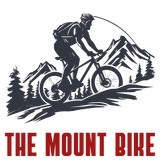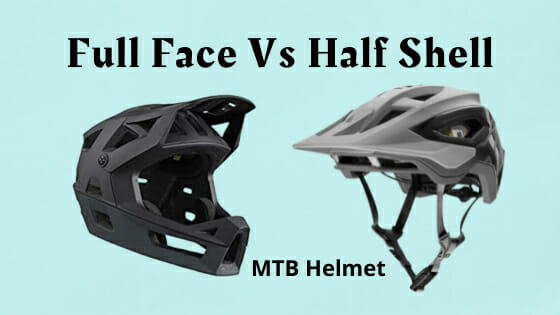A helmet is a basic but necessary accessory for your safety. But which type of helmet should you choose? Full-face or half Shell helmets? Both have advantages and disadvantages.
The main difference between Full-face vs half Shell MTB helmets is the chin bar. The full-face helmet covers your entire head, including your chin and jaw. While the half Shell helmet covers only the top of your head, leaving your chin and jaw uncovered.
This article will help you make up your mind with all the information and factors that must be considered when making this decision.
Full Face Vs Half Shell MTB Helmets Comparison Chart
This table shows the main difference between these two popular MTB helmets:
| Characteristics | Full Face | Half Shell |
| Weight | Heavier | Lighter |
| Field Of Vision | Worse | Better |
| Protection | More | Less |
| Ventilation | Bad | Good |
| Breathability | Bad | Good |
| Price | Expensive | Cheap |
Full Face Vs Half Shell MTB Helmets: Key Difference
Since you already know the details in short, here’s an in-detailed comparison of these helmets. Let’s get into it.
- Chin strap
This is a conventional chin strap so it goes over your ears, around them, and underneath your chin and clicks into place a little bit more about the straps.
Half-shell helmets have some adjustment around the ear, whereas the park one here has got this bridge which is the same that will fit anyone and again less adjustment with these modern-day open-face helmets.
- Adjustments
There are adjustments everywhere. A bit like this peak, you can fully be adjusted to give you a little bit more room so you can run glasses or even.
Half-shell helmets tend to be more adjustable. They’ve got more adjustability around the ears so that you can fit them to your head.
You can store your goggles and your glasses with the glasses, you can store them within your little visor peaks right here, or even better, your goggles just like this.
- Integra System
Depending on the helmet, it could also have an integrated visor attached to the front of the helmet.
It’s only going to give you a certain amount of coverage, depending on how you want it to fit, and there is quite an adjustment, so you can get it just right.
There is also a strap that goes across your forehead to tighten down on your head and just pull in that snug fit, so safety is at its maximum when you’re wearing a helmet like this. Both helmets have these features.
- Dial Button
You’ve got a number of them depending on how you want the helmet to fit the contour of your skull, you’ve got this big adjustment on the rear.
And you’ve got this little dial as well to just bring in the helmet to give you a nice snug fit so it’s not so loose.
- Protection
Here you’ve got the full-face one that goes right around your eyes and your chin, which is going to offer you a lot more protection.
The open-face helmet has got this bit sticking out the back and again what would be hitting the ground will be your forehead and then some of your face as well.
However, it’s very important that this bit is longer than what’s in the half shell so it’ll protect all around the back of your head as well.
- Cheek pads
The open-face helmet has got a little bit of padding that you can get to just add a bit more of cheek to the helmet, and it’s going to give you better protection on the chin area.
However, this will protect your head from crashing into things. Half shells have got a plastic covering over them, so they’re easier to crash into things.
Also, you’re seeing a lot of these days, these sorts of safety features on the pads so they can pull release in the event of a big crash.
If you do maybe have a head injury or a neck injury, people that come to help you can safely remove these pads without jerking the helmet on your head, and how much will come off nice and easy.
- Chin bars
There’s another option that can seem quite appealing to some riders at these. These are not in the market anymore, but they do exist.
The chin guard was a separate part that you could wear very simply in and out depending on whether you wanted to wear it or not.
This is a full-face helmet so it’s got a chin guard attached to the helmet itself, so you can’t remove it.
So this helmet is good if you’re going to be doing some serious off-roading and don’t really want to take any chances.
When to Get a Full-Faced MTB Helmet?
You should wear a full-face mountain bike helmet when you’ll ride at high speed. This is because it offers better safety and protection than a half-shell helmet. It’s also ideal for doing stunts, racing downhills, or participating in competitive events.
In other words, if you want maximum protection, then you should go for a full-face helmet. However, they aren’t recommended for casual riding since they can be quite uncomfortable.
When to Get an Open-Faced MTB?
You should wear a half-shell mountain bike helmet when you won’t ride at high speed or do any stunts.
These helmets offer sufficient safety and protection for casual riding. They’re also more comfortable than full-face helmets and offer better breathability and visibility.
If you’re looking for an affordable option that does not compromise on safety, then this is the best choice
What to Look For In Mountain Bike Helmets?
MTB helmets are a must for any serious rider to protect and look cool. So, what should you be looking out for if you’re new to the sport or just have your eye on some new kit?
- Lid size
Always try on the helmet before buying! Mountain biking helmets come in almost every size imaginable – kids’ models, full-face ones, oversized ones, and all different shapes.
Whilst the majority of helmets are size 52 or 53, try on a few if you’re not sure to be on the safe side.
Helmets come in various sizes because they’re measured from front to back (inside to outside), and child helmets have a shorter measurement than adult models.
- Construction
Most mountain bike helmets are constructed from rigid plastic or even carbon fiber. These materials provide a strong shell that is both protective and light, making them one of the best all-rounders on the market.
- Open-Face/Closed Face
A full-face helmet is most secure on roundhouses and other sharp turns. However, a closed-face model will protect your face in the event of an impact by transferring all the force onto the helmet – it’s better to protect your facial features with a cheek pad.
Also, if you’re buying a full-face model, ensure the chin strap is long enough. A long chin strap will allow you to remove your helmet easily while taking a breather.
- Visor
A visor is a very important safety feature, but it’s also nice to look at while riding. The visor on the top half of the helmet can be removed and replaced with a clear visor that gives a better field of view as well as allows you to look around your helmet.
Which One to Choose Full Face Vs Half Shell?
Here are some tips to help you decide which style of helmet is right for you.
- The half shell can have vents, which might help cool your head in hot weather, while the full face may trap heat around your head.
- A half-shell helmet will be more aerodynamic, while the full face will protect your head more.
- The full face looks more astonishing to many people and can be used for off-road and on-road biking.
- A half shell might give better visibility for night riding than a full-face helmet.
- The Half Shell helmet has a more modern look, which can be cool in the bike shop.
- A half-shell helmet may not fit if you have fine hair or no hair on your head.
- The full face will be more expensive because it has many parts that are needed to attain aerodynamic balance.
FAQs
- Is a full-face helmet better?
Yes, a full-face helmet is better than other helmets. MTB helmets are designed for mountain biking, but their uses extend far beyond the trails. They can also protect a variety of outdoor activities and keep you safe on the road.
- Do you need a full-face for the bike park?
If you’re riding in areas where there are no pedestrians or vehicles, then a full-face helmet is the best choice for mountain biking. It provides the most safety for your face and head.
- How do you wear a full-face mountain bike helmet?
Adjust the straps and the chin strap so that the helmet feels tight. Make sure you can’t easily pull it off and rock it from front to back, gently. You want it to stay centered on your head and not slide around too much.
Conclusion
In the end, we found no significant differences in weight, fit, and comfort between a full face helmet vs half shell MTB helmets. We think the main factors to consider when buying a new helmet are style, brand, and protection.
For protection, a full-face helmet is best. However, if you’re looking for a stylish, light, and functional helmet to commute, trail, or local riding, then a half shell may be the better choice.

I am Ryan Ford, a mountain biking enthusiast who loves to explore the outdoors. I also like to go on adventures with friends and anything else that involves being outside. I love my bike because it gets me out of the house and gives me an opportunity to enjoy nature.

